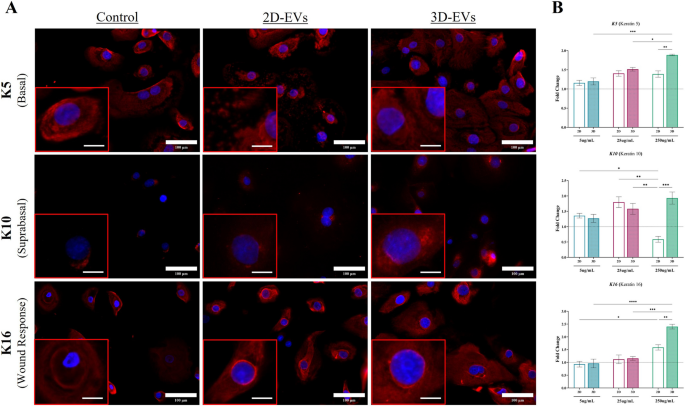Overland Park, KS – In a groundbreaking development, a recent peer-reviewed paper titled “Mesenchymal Stem Cell Extracellular Vesicles from Tissue-Mimetic System Enhance Epidermal Regeneration via Formation of Migratory Cell Sheets,” published on July 29, 2023, in the journal “Tissue Engineering and Regenerative Medicine,” offers open access to its findings.
The research introduces a novel tissue-mimetic 3D hydrogel system from Ronawk known as Bio-Blocks™ which enhances the regenerative properties of the ASC phenotype. By comparing the functional secretome differences between 2D and 3D environments, the study highlights the importance of Ronawk’s culture platform setting and how it influences the secretory dynamics of ASCs and thus positively impacts the output of extracellular vesicles (EVs).
The lead author, Jacob G. Hodge, Ph.D., sheds light on the crucial role of EVs in driving epidermal regeneration and the impact of the specific culture environment used to enhance regenerative capabilities.
Led by a team of scientists from both industry and academia, the study investigates the impact of culture environments on adipose-derived mesenchymal stem cell (ASC) secretome regenerative capabilities. The findings challenge traditional 2D culture techniques and provide a unique approach to understanding wound healing and epidermal regeneration orchestrated by keratinocytes.
Key findings from the study include:
● The culture within the tissue-mimetic system enhances protein secretion by approximately 50%, primarily from the > 100 kDa fraction.
● The ASC-secretome’s ability to modulate keratinocyte activities, such as migration, proliferation, differentiation, and morphology, resides within the “>100 kDa” fraction.
● The 3D ASC-secretome, enriched in EVs, shows the most promising results in enhancing epidermal regeneration.
● ASC-derived EVs induce morphological changes in keratinocytes, resembling natural regeneration and promoting the formation of stratified cell sheets.
● The 3D-EVs promote collective cell sheet migration and an epithelial-to-mesenchymal-like transition in keratinocytes, while 2D-EVs exhibit an anti-migratory stimulus.
● 3D EVs promote and enhance proliferation, migration, and metabolism.
● 2D EVs inhibit proliferation, migration, and metabolism.
The study’s findings offer new insights into the direct role of EVs in keratinocyte wound healing and epidermal regeneration. The potential clinical benefits of mesenchymal stem cell-derived EVs in augmenting regenerative processes are underscored and certainly deserve further investigation. Using Bio-Blocks as a primary cell culture platform for producing EVs warrants consideration by anyone doing cell culture in an academic or industrial setting.
“This study demonstrates the transformative potential of utilizing Ronawk’s Bio-Blocks for EVs in advancing epidermal regeneration,” notes Jacob G. Hodge, Ph.D., lead author of the paper. “The findings not only enhance our understanding of wound healing processes but also opens the door to innovative clinical therapies.”
The paper signifies a significant step towards harnessing the power of biotechnology for medical advancements. The implications of the research are far-reaching, offering hope for improved treatments for various skin-related conditions and injuries.
The full paper can be accessed here:
https://link.springer.com/article/10.1007/s13770-023-00565-6#Abs1
About
Ronawk’s Bio-Block Universe™ is the first expandable Bio-Factory designed to accelerate the development of biotechnology applications, processes, and technologies. By leveraging advanced mimetic culture technology, Ronawk’s Bio-Block Universe™ streamlines cell and tissue production, ultimately expediting research for next-generation therapies.
Ronawk’s Bio-Block Universe™ simplifies the once-tedious process of mimetic-culture workflows by minimizing labor, consumables, and space. Bio-Block™ technology employs biomimicry of soft tissues to optimize the growth of cells outside the body in a way that closely mirrors their natural growth within the body. This approach not only increases biological opportunities but also ensures cell viability, preservation of key characteristics, and secretion of therapeutic biologics. The process also decreases senescence and risks of contamination by eliminating subculturing from the process.
Ronawk’s Bio-Block™ platform is customizable, offering a consistent, repeatable, and scalable bio-mimetic microenvironment production that accelerates research and paves the way for innovative regenerative therapies. By harnessing the power of mimetic culture technology Ronawk is committed to transforming the field of biotechnology and advancing the development of life-changing treatments for patients in need.
